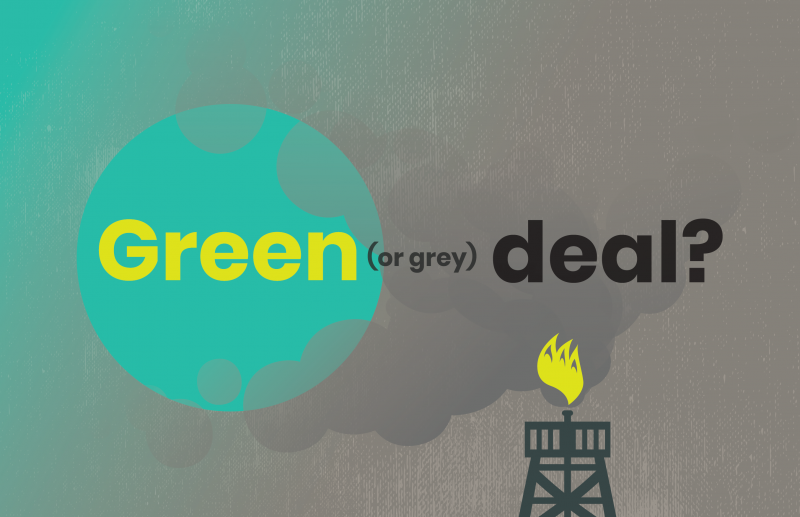
A grey deal?
Fossil fuel fingerprints on the European Green Deal
The European Green Deal (EGD) is a major new plan for the EU that seeks to make its economy 'climate-neutral'. Its mere existence is a positive first step; but is the deal really as good as they want us to believe? The fingerprints of industry, and in particular the fossil fuel industry, can be seen all over the EGD. Carbon trading will continue to allow big polluters to slow the transition, emissions reductions targets are too modest and too slow, fossil gas is kept as a transitional fuel, and public money will finance industry ‘false solutions’. The fossil fuel lobby is taking advantage of its privileged access to policymakers, as well as the corona-crisis, to secure these gains. How did this happen?
What is the European Green Deal?
The European Green Deal (EGD) is a new 'environmental' growth strategy that seeks to make the EU economy 'climate-neutral' and where "economic growth is decoupled from resource use". It is the jewel in the crown of the new European Commission, and in particular of President von der Leyen and Frans Timmermans, Vice President in charge of the EGD. When Ursula von der Leyen was vetted to become Commission President, she convinced a key number of members of the European Parliament by promising to present a European Green Deal within 100 days of taking office. The proposal was presented in 11 December 2019, and Von der Leyen proudly called it “a man on the moon moment” for Europe.
The EGD covers an impressive range of areas, from climate and energy policies, transport, agriculture and food, biodiversity, industrial policy, to manufacturing and construction.
Its mere existence is a testimony to the success of climate movements, who have been putting increasing pressure on decision makers to take action.
The official version of the EGD has sold us a rosy picture: “[the EGD] is about improving the well-being of people. Making Europe climate-neutral and protecting our natural habitat will be good for people, planet and economy. No one will be left behind.”
Too good to be true?
While the EGD contains important elements that take us towards the right direction – in areas such as transport, agriculture, biodiversity, and the circular economy – it falls short of what is needed.
Crucially, the EGD will not phase out fossil fuels, despite the fact that scientists say for humanity to have a chance at a liveable future we need to leave most fossil fuels in the ground. It’s also fails to match its words with money; as a Guardian op-ed points out it is “largely composed of reshuffled money from existing EU funds and reheated promises to mobilise private-sector capital down the road”.
But mostly it falls short because in spite of all its rhetoric the EGD does not seek to transform, but rather to accommodate, the status quo. It does not rethink the economic system that is the root cause of the climate, ecological, and financial crises. It continues to promote economic growth while seeking to manage the environmental and social impacts. There are key aspects of EU politics that need to change to tackle these aforementioned problems: not least, single market rules, and the use of market-based mechanisms instead of binding regulations to address the environmental crisis. Nor does the EGD substantially address the historic responsibilities of the EU and its role in the unjust global system. It does not contemplate the need to include debt cancellation, the end to the resource grabs from developing countries, and the reduction of energy demand in the EU. The EGD is in sum trying to fight against climate change while giving precedence to the interests of corporations. And unfortunately, that is just not possible.
Besides, the focus on a timeline for 2050 is simply too late. Bold action to tackle the climate emergency is needed now.
And the climate targets? At least these are ambitious aren’t they?
Well unfortunately… the targets are too little, too late.
On 4 March 2020, the Commission proposed the Climate Law, a centrepiece of the European Green Deal. It is designed to set a legally binding target for the EU to reach 'net-zero' emissions by 2050 and intermediate targets for 2030. The current target for 2030 (decided in 2014) is a 40 per cent reduction compared to 1990 levels, and it was clear at the time it was set that this is a ridiculously low target. Climate NGOs demand a EU target of 65 per cent emissions reductions cuts by 2030 to limit global heating to 1.5°C, based on what science and equity requires.
What the Commission has proposed now is to “explore options for a new 2030 target of 50 to 55 per cent emission reductions compared to 1990”. And IF they decide that it is necessary to amend the current target of a 40 per cent reduction, they will make a proposal to the European Parliament and the Council.
Jytte Guteland, the Swedish rapporteur for the Climate Law in the European Parliament, says she will back a 65 per cent emissions target for 2030: “I think it is important in these times to submit proposals that are in line with what scientists said it is necessary.” However, Frans Timmermans has already said that the Commission will not propose anything more than 50-55 per cent.
Over 30 youth strikers, including Greta Thunberg, reacted to the proposed Climate Law calling it a “surrender”.
“We don’t just need goals for just 2030 or 2050. We, above all, need them for 2020 and every following month and year to come.”
They explain, “Because distant net-zero emission targets will mean absolutely nothing if we just continue to ignore the carbon dioxide budget – which applies for today, not a faraway future.”
So yes, too little too late.
But being climate neutral is a good thing, right?
To be ‘climate neutral’ or to have ‘net-zero emissions’ by 2050, means that while some greenhouse gas emissions will be cut, some fossil fuels will continue to be burnt under the EGD. These will be ‘balanced’ or 'offset' with an ‘equivalent’ amount of so-called ‘carbon removal’. This can include for example storing the carbon produced underground, as with unproven technologies such as carbon capture and storage (CCS, see below), or preserving or planting forests in order to 'sequester' the carbon.
There are a lot of problems attached with the removal of carbon. These include carbon placed in forest sinks or geological stores leaking back to the atmosphere; or fuelling land grabs in order to grow industrial plantations that are counted as carbon offsets. These have major impacts on communities and can even destroy existing ecosystems and natural carbon sinks. Moreover these 'carbon offsets' enable the continued extraction and burning of fossil fuels in other places in the world.
These 'solutions' not only come with serious problems; they may not even remove carbon, rendering the promise of 'net zero' an illusion. The only way to actually get to 'zero' emissions is to stop burning fossil fuels.

So what about the fossil fuel industry endorsement of the `net-zero´?
No wonder that big polluters such as the fossil fuel industry are happy with the EGD goal of ‘net-zero’. This enables them to focus on the ‘removal’ of carbon, rather than on cutting their emissions. It allows them to keep burning fossil fuels, to lock us into building more fossil fuel infrastructure, and even to make yet more money out of these ‘false solutions’.
For instance the oil major Eni has promised to offset its oil and gas operations by planting forests in Africa. It speaks about employment and other benefits for the communities, legitimising fossil fuel extraction. But in reality, this amounts to a land grab of 8.1 million hectares in Africa for industrial plantations, not forests. These plantations have negative impacts on local populations and ecosystems. Eni is not the only big oil and gas major who has embraced ‘net-zero emissions’. Repsol, Total, BP, and Shell among others have also done the same.
Does this mean they are going to stop burning oil and gas? No, they will actually increase their oil and gas production. Total’s chief executive said weeks before his company promised to become net-zero that: “We don’t want to go away from oil and gas. We have all the financial capacities to be in the driving seat [of the energy transition]”. He explained that by 2040, 50 per cent of Total’s activities will focus on gas, 30 per cent on oil and biofuels, and 20 per cent on electricity.
And how is Shell, for instance, planning to get to its 'net-zero future'? You would think by reducing its oil and gas extraction in the first place. Yet Shell is forecast to increase output by 38 per cent by 2030 (increasing its crude oil production by more than half and its gas production by over a quarter). Fossil gas (which Shell claims is clean), CCS, and tree plantations, are among the ‘false solutions’ they wave like a magic wand to conjure up 'net zero'.
No matter their rhetorical promises, the world can’t take their increase in fossil fuels.
So ‘net-zero emissions’ and ‘climate neutrality’, may prove to be a Pandora's box that gives big polluters free reign to employ the whole toolbox of fake climate ‘solutions’.
Wait, hold on, false solutions, what’s that?
Let's explain some of the jargon:
False solutions: These are generally 'solutions' that allow fossil fuel companies to keep polluting with not much disruption to their business model. They do not fundamentally solve climate change and in fact can be a dangerous distraction from real action, locking us into planning for and building infrastructure for a fossil-fuelled future, rather than one fuelled by renewables.
Carbon capture and storage (CCS): Fossil fuels are still used in electricity generation and industrial processes, but instead of the carbon dioxide being released into the atmosphere, it is captured and stored underground or underwater. There are numerous practical problems associated with CCS: for one, it is massively expensive and would cost far more to implement than simply switching to renewable energy. More worryingly, it is an unproven and dangerous technology that defers the phase out of fossil fuels with promises that are always a decade away.
Carbon capture and utilisation (CCU):The process of capturing carbon dioxide to be recycled for further use. It primarily supports oil extraction and the fertiliser industry, and often sees the release of captured CO2 back into the atmosphere after it is used. It also facilitates Enhanced Oil Recovery, where carbon dioxide is pumped into depleted wells in order to extract more oil.
Reality check: These technologies essentially allow dirty energy power plants and fossil fuel infrastructure to continue to be built on a speculative, risky promise that in the future we will be able to bury CO2 emissions.
Hydrogen, renewable gas, low-carbon gas, decarbonised gas:
Green hydrogen: This is a type of renewable gas. It is non-fossil gas produced from renewable electricity via electrolysis in a power-to-plant (P2G). To be clean it really would need to be made from excess renewable electricity, so is not very realistic to increase by a large amount the scale in which it is now produced, as there will not be enough excess renewable energy in the EU.
Blue hydrogen: This is produced from fossil gas using ‘steam methane reforming’, capturing the CO2 with CCS, carbon capture and storage. Referred to also as ‘decarbonised’ or ‘low carbon’ gas.
Turquoise hydrogen: This is produced from fossil gas using ‘molten metal pyrolysis’ technology, which produces hydrogen and solid carbon. This technology, the new industry hype, is still in the laboratory phase. Referred to also as ‘decarbonised’ or ‘low carbon’ gas.
Grey hydrogen: This is produced from fossil gas using ‘steam methane reforming’, without capturing the CO2.
Reality check: A staggering 96 per cent of current hydrogen is based on fossil fuels. Given the virtual non-existence of renewable gas, and the non-existence of commercially viable CCS at scale, fully carbonised fossil gas will continue to be used (for heat, in gas-fired power plants, and in creating hydrogen). The industry narrative of so-called renewable gas is being used to provide cover for ‘decarbonised’ gas or ‘low carbon’ gases (see question below).
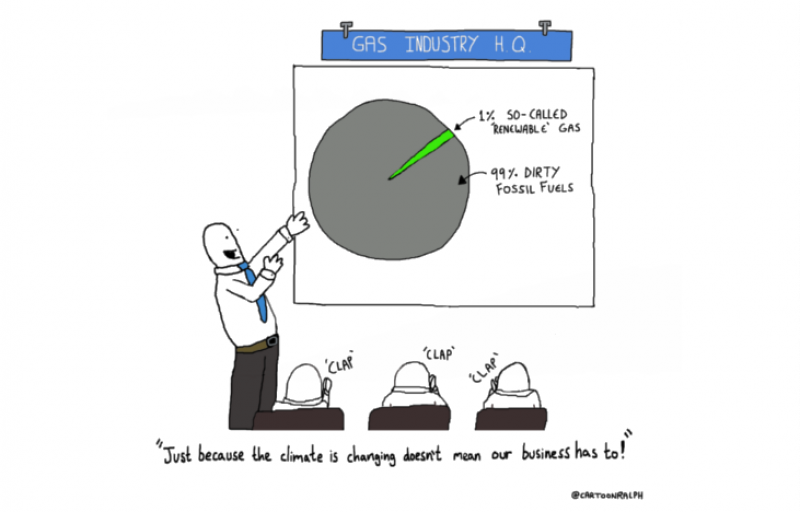
Emissions Trading System (ETS): This is the European Union’s flagship climate policy. It is intended to establish a legal limit (or 'cap') on carbon dioxide emissions (and more recently, those of other greenhouse gases) by making it expensive to pollute beyond this limit. The basic idea is that it sets an overall legal limit on the CO2 emissions of over 11,000 power stations, factories, and flights covered by the scheme, which account for almost half of the EU’s greenhouse gas emissions.
Reality check: No surprise that the ETS is a darling of big polluters. It has failed to reduce emissions since it began in 2005, has resulted in windfall profits for the worst polluters, has weakened more efficient tools such as renewable energy and energy efficiency, and has proven totally permeable to industry lobbying, which has managed to keep it full of loopholes throughout successive reforms, and in sum, has been shown to have unsolvable conceptual issues.
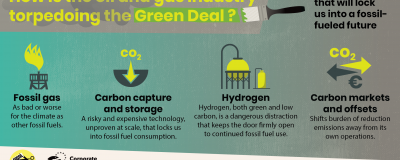
But why would policymakers agree to this given we are facing a climate emergency?
Have you ever heard of corporate capture?
For decades the role played by big polluters and their lobbyists, and their cosy relationship with officials responsible for climate and energy policies, has been a major obstacle to achieving effective EU policies to tackle climate change. They have captured the agenda, with their own profit motives placed before the interest of the climate and the people.
Big polluters, including the fossil fuel industry – one of the most responsible for causing climate change – have spent literally hundreds of millions on lobbying the EU. This money pays for a wide variety of tactics, from hiring experienced lobby firms, to organise a myriad of events, to get privileged access to policymakers, to exploiting the revolving door between public office and the private sector. Unfortunately, the grip by big polluters on decision-making has resulted in decades lost to really tackle the climate crisis, with far too many examples of wrong or watered down climate and energy policies.
One key example is how big polluters have been instrumental in pushing for an EU climate policy focused on emissions trading, at the expense of ambitious renewable energy and energy efficiency measures. The gas industry also supports the ETS because it helps them to out-compete coal.
Shell and other oil majors successfully undermined the EU 2030 renewable energy targets in 2014, when the EU decided that the 27 per cent target for renewables in the energy mix would not be binding on individual member states. And despite gas being as bad or worse than other fossil fuels, gas is at the heart of the EU’s 2050 climate long-term strategy.
The insidious influence of the fossil fuel lobby has also left its fingerprints on the EGD proposal, which gives a prominent role to the ETS, even considering extending it to other areas such as maritime and road transport, while granting gas a significant role well into the future.
How did industry manage to influence it?
To start with, privileged access!
The European Green Deal is the number one most lobbied-on topic in Brussels. Let’s zoom in on the first hundred days after the launch of the European Green Deal on 11 December 2019. This period was crucial to steer key EGD elements, such as the Climate Law, and showed a flurry of lobbying activity. During this time, key members of the Commission in charge of the EGD (Commission’s President von der Leyen, EGD Commissioner Timmermans, Energy Commissioner Simson, their Cabinets, and directors-general for Energy and Clima, Juul-Jørgensen and Petriccione,) met 151 times with business interests representatives. That’s around 11 meetings a week! In comparison, they only met 29 times with public interest representatives, which is about 2 meetings a week.
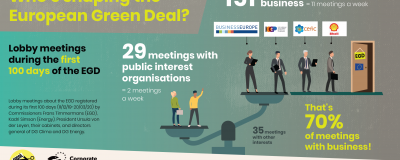
The fossil fuel industry is a hungry pack with a keen interest in moulding the EGD to their interest, and they alone had 2 meetings a week with key Commission executives during those first 100 days. Commissioners Timmermans and Simson were their preferred targets.
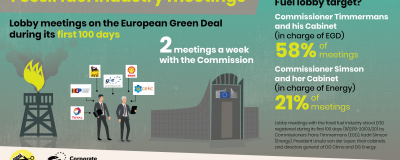
The number of meetings on the EGD that decision-makers are having with the industry is disproportionate, and give an early indication of the degree of privileged corporate access that will mark the van der Leyen Commission. However, the number is even higher if we take into account that most of the lobby meetings with Commission officials actually take place at a level below the directors-general, the commissioners, and their cabinets. But we can not know how many of these took place, or with who, because the transparency rules are very limited and only cover the top Commission posts, around 300 people of the almost 30,000 Commission staff. SidenoteSince 2014, Members of the European Commission, their cabinets and Directors-General of the European Commission have to disclose publicly their meetings, and cannot meet lobbyists that are not registered in the Transparency Register.
To hold public officials accountable it should be possible to discover what was discussed at their meetings with lobbyists, so we tried to find that out using the access to documents regulations.
Looking at the meetings that were registered during the 100 first days of the EGD revealed an appalling lack of transparency. Commissioner Timmermans and his Cabinet, in charge of the EGD and with by far the highest number of lobby meetings, are not filing minutes on the many they are conducting – mostly with industry – to discuss the EGD. Out of 56 meetings we were only given minutes to 3. To mention just a few, they held meetings with Shell, Eurogas, Polska Grupa Energetyczna (PGE), the European Chemical Industry Council (Cefic), Eni, and Gas Infrastructure Europe, all from the fossil fuel industry and with big stakes in shaping the deal. SidenoteDG Energy and President von der Leyen scored better. In our first request to Timmermans and his Cabinet, out of 45 meetings we only got access to minutes of 3. Of all the others, no record was filed. In the second request, out of 18 meetings we only got access to minutes of 6, all with Director General Mauro Raffaele Petriccione, and those are in most cases only few bullet points or vague accounts, not full minutes.
How close is the fossil fuel industry to policymakers in the creation of the EGD?
Apart from the major fact that there is a shared ideology between top decision makers and the corporate interests, which already constitutes a hard wall against transformational policies, corporate lobbyists reinforce their influence in many ways.
Access is one part of a multi-prong strategy. Another is producing as many position papers, letters from the big bosses, and lobby emails as you can. Present yourself as a partner and key part of the solution, ignoring the fact that you are the one causing the crisis. For instance FuelsEurope and IOGP (the international oil and gas producers trade group) representing hundreds of fossil fuels companies such as ExxonMobil, Shell, BP, and Saudi Aramco, wrote several times to Commissioner Simson to lobby her on the EGD during her first month in office.
To get your foot in the door of the EU institutions is a winning strategy, as shown in the example of the European Energy Forum (EEF), a MEP-industry forum which is very useful to pass on corporate demands and to secure their presence in the European Parliament without too much publicity. The EEF brings together 22 MEP members with 84 corporate associate members, including Shell, Total, ExxonMobil, BP, Chevron, and Eni. In February 2020 the EEF organised a “dinner debate” in partnership with the fossil fuel industry lobby group, IOGP, about the role of oil and gas in the European Green Deal, to promote the role of CCS, hydrogen, and oil and gas infrastructure. They also had representatives from the Commission and the Croatian Ministry of Environmental Protection and Energy (very influential as Croatia held the EU presidency at the time).
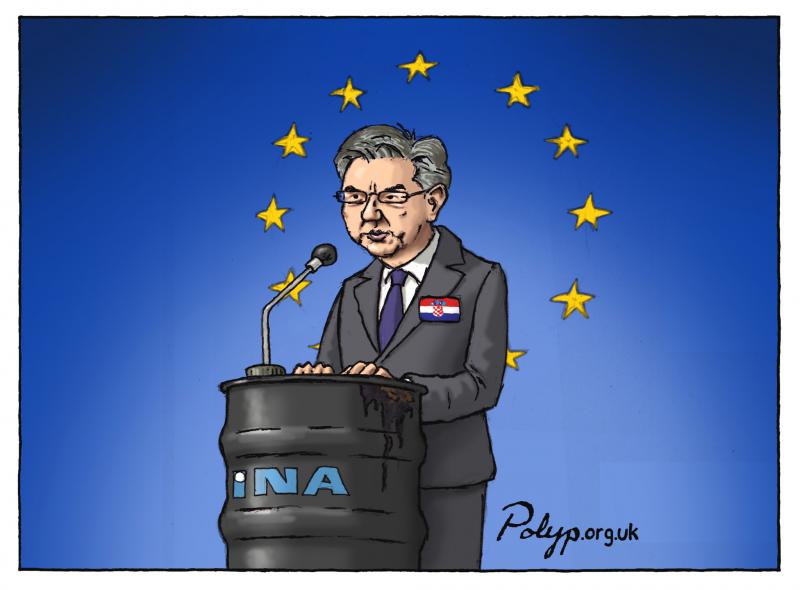
INA, a Croatian oil and gas company, sponsored the recent Presidency of the EU when it was held by Croatia.
This is not an isolated example. Many policymakers are unfortunately all too eager to participate in events with the fossil fuel industry. For instance both Commissioners Simson and Timmermans have accepted Eurogas invitations to their annual conference (now moved to 1 October 2020). Kadri Simson spoke recently at an event on how to achieve climate neutrality by 2050 sponsored by Shell.
Revolving doors also come in handy: these are cases where EU institutions hire “policy experts” that have had careers in the very same corporate sectors they are then tasked to help regulate, or the other way round. For example Aleksandra Tomczak, a current member of Timmermans' Cabinet whose responsibilities include the internal energy market and the Just Transition Fund, worked for almost five years until 2015 for the World Coal Association, the lobby group for the coal industry. Although the time elapsed between both positions is long enough that it is not covered by EU ethics rules, she’s the official most targeted by the fossil fuel industry for EGD meetings. Revolving doors can make contacts easier for the industry, and render policymaking more permeable to industry’s interests.
Hiring lobbying guns also helps the fossil fuel industry to get closer to policymakers. Some of the biggest oil and gas companies, directly or via their trade groups, pay enormous amounts of money to lobby consultancies. For instance in 2019, FuelsEurope, IOGP, ENTSO-G (the European Network of Transmission System Operators for Gas), PGE, and Cefic (the lobby group for the chemical industry), together paid up to one million euros to lobby consultancy Fleishman Hillard, which has made the EGD its key priority for 2020 and 2021. Weber Shandwick, another lobby firm representing Gas Natural Fenosa, Eni, Snam, Repsol, and Shell, also put the EGD on top of its agenda. It organised an event to give advice on lobbying, “navigating the EGD” which brought together industry and decision makers from the Commission and member states.
So what does the fossil fuel industry want from the EGD?
The fossil fuel industry wants the EGD to focus on ‘solutions’ that allow them to keep their business model, based on the extraction and production of fossil fuels, or at least to control the energy transition as much as they can, making sure they can keep profiting from it.
They also oppose more ambitious emissions reduction targets, though not always very openly. Brussels’ most influential big business lobby group, the employers' confederation BusinessEurope, is a good example of this. A memo leaked in 2018 exposed how it instructed its corporate members with various lobby strategies to oppose, delay, or deflect the EU’s plans to increase the ambition of its targets.
Recommendations included “be rather positive” about action to tackle global warming “as long as it remains a political statement with no implications” on policy.
And to challenge processes and use delaying tactics by asking for “more transparency on the calculations” and requiring “an impact assessment” to evaluate the costs and benefits before taking any action. The goal is to hamper climate action that could dent its members’ profits: BusinessEurope’s Corporate Advisory and Support Group includes BP, ExxonMobil, Shell, and Total, as well as EDF, Engie, Eni, Equinor, Lukoil, OMV, and Repsol.
Now that the Climate Law has finally put the revision of emissions targets on the table, BusinessEurope has renewed its lobbying efforts. With its usual privileged access, it met with the DG Clima Director General on 24 October 2019 to discuss the EGD even before it was proposed, to argue “any possible modification of the 2030 targets”. On 2 March 2020 it met with Kurt Vandenberghe, member of the Cabinet of President von der Leyen, and putting in practice its advice to its members, it claimed that BusinessEurope “generally supports the European Green Deal and will be a constructive partner, but points to a number of conditions that will need to be put in place.”
What about gas?
The push for gas is a core demand of the fossil fuel industry for the EGD. Industry has been relentlessly lobbying on energy policymaking for many years to give gas a star place. The campaign has paid off, and while the EGD calls for the phase out of coal, it supports ‘decarbonised’ gas.
We have already explained why gas and oil majors like Shell or Equinor, which want to keep selling gas, support fossil hydrogen and the use of CCS. Less picky part of the gas industry are those building and operating the pipelines, the gas transmission operators or TSOs, such as Enagás, Fluxys, Snam, Gas Infrastructure Europe, or ENTSO-G, the lobby group set up by the Commission. They don’t care so much about the type of gas as long as their pipelines are used (and built). For instance, largeSpanish TSO Enagás had a meeting with energy Commissioner Kadri Simson in January 2020, where it promoted the use of fossil gas as “substitution for more emitting fossil fuels”. ENTSO-G, in another meeting with Commissioner Simson lobbied for new gas infrastructure, hydrogen-proof. TSOs do not hesitate to use renewable gas as a cover to ask for gas infrastructure, but the reality is that we do not need more: a study by consulting firm Artelys concludes that existing EU infrastructure is capable of meeting a variety of future gas scenarios, even in the event of extreme supply disruption cases.
Industry has also been successfully asking for public funding for the risky technologies needed for ‘decarbonised’ gas. The European Green Deal says that at least 35 per cent of the budget of Horizon Europe (a big pot of EU money for research and innovation) will fund new solutions for climate, mentioning specifically “clean hydrogen”. Invest EU, another fund featured in the EGD, will allocate 30 per cent of funding to fight climate change, but this can include gas and CCS. And the leaked draft of the imminent Commission’s Hydrogen strategy (to be published 8 July 2020) see cumulative investments of €3 billion to €18 billion by 2050 for “low-carbon fossil-based hydrogen” with carbon capture technology. The strategy prioritises green hydrogen but keeps the door open to fossil gas. “The gas lobby has massive influence on the EU hydrogen strategy,” according to Green MEP Michael Bloss: “This means that money is being sunk into a fossil billion-euro grave.”
In short, public money will shoulder a substantial part of the costs for expensive technologies that the fossil fuel industry has managed to sell as a solution to the climate, but that will extend their core business beyond what the planet can take.
Has the corona-crisis been a setback for the fossil fuel lobby?
Despite some of the usual lobby tricks (meetings, events, and cosy get-togethers) coming to a halt, the fossil fuel industry has found many ways to shamelessly use the crisis to lobby for their commercial interests. They never waste a good crisis!
When Cambre Associates, a public relations firm representing important actors of the fossil fuel industry such as the European Confederation of Fuel Distributors, Cefic, and Gasunie, says it was “busier than ever” during the lockdown period, we believe it!
BusinessEurope wrote to the European Council President Charles Michel to demand “temporary derogations from normal regulatory requirements”, wanting environmental and fiscal regulation postponed or weakened. It also wrote to Commissioner Timmermans requesting all EU initiatives not directly linked to the health and economic crisis be put on hold, including key elements of the EGD such as the Climate Law. And in a recent meeting with Timmermans, BusinessEurope President Pierre Gattaz, lobbied among other things for continuous free permits to pollute under the ETS, and used the corona-crisis to throw a span in the wheels of increased climate targets: “The impact assessment [for the Climate Law] should assess the long-term impacts of COVID-19 on the ability of Member States and sectors to reach higher 2030 climate ambitions”.
The crisis has been a hook for many fossil fuel companies to meet with policymakers and push their real agenda forward. As the lockdown began, face to face lobby meetings were substituted for online ones. Between 23 March and 26 May 2020, 25 meetings of fossil fuel lobbyists were logged by the key Commission officials in charge of climate and energy policymaking. That’s three a week during the lockdown period, with big polluters such as Total, Shell, FuelsEurope, Cefic, and Hydrogen Europe.
Fossil fuel lobbyists also organised multiple online events, sometimes with EU official speakers, to promote false solutions. For instance, the Eurogas online event Can Europe reach climate neutrality without targets? included on the panel the Energy Attache from the Permanent Representation of Germany to the EU (Germany holds the rotating EU presidency for the second half of 2020) who made clear that all colours of hydrogen will be embraced by EU policy.
But they are saying recovery will be green!
Commission President Von der Leyen declared that she wanted the European Green Deal at the centre of the EU’s recovery strategy. And as with the EGD, the new recovery instrument, “Next generation EU” builds on the continued support for fossil gas.
In his opening remarks at the 'Green and Just Recovery' plan, Commissioner Timmermans said that InvestEU “will provide an EU guarantee of roughly 20 billion euros to sustainable infrastructure projects”, including clean hydrogen and carbon capture and storage. Timmermans later confirmed that the use of fossil gas will remain a “caveat” in the recovery plan. Needless to say, the oil and gas industry is very happy.
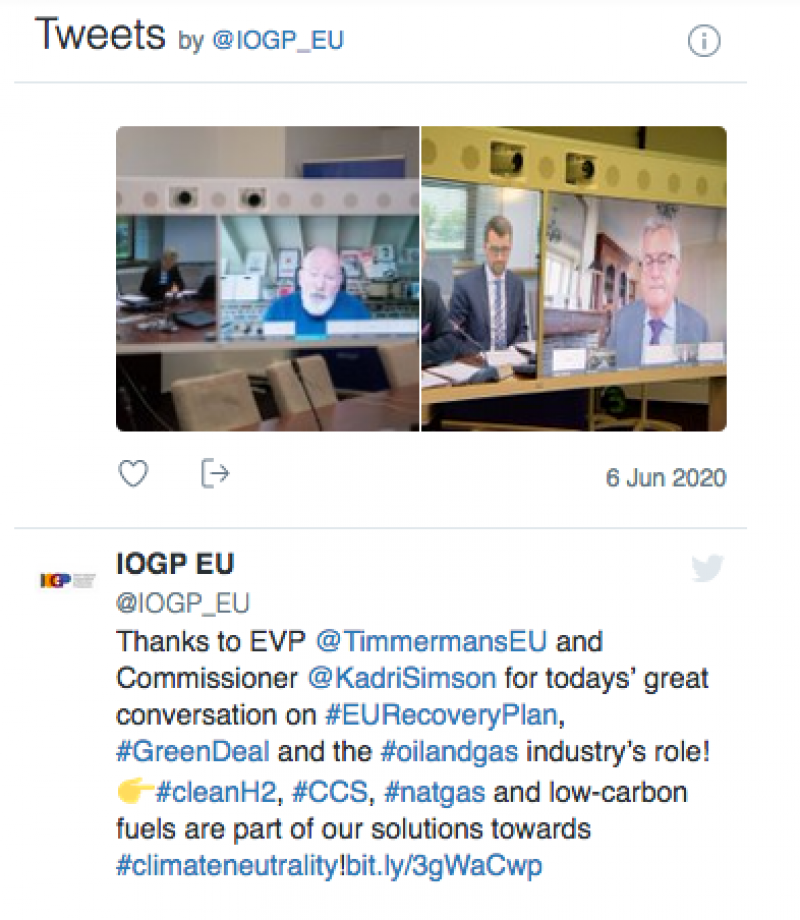
Locking us into more fossil fuel use is no way out of the corona-crisis, in fact it guarantees another, far larger one: the climate crisis. Despite this the fossil fuel industry is repackaging their demands to present themselves as a solution. For instance on 20 April 2020, Eurogas, Hydrogen Europe, ENTSO-G et al wrote to the EU institutions, requesting renewable and decarbonised gases be a “central pillar of the stimulus package”.
IOGP didn’t waste its time either, sending a letter to the members of the Parliament on 7 May 2020 to share its recommendations ahead of a recovery plan’s meeting. Like ENTSO-G, the oil and gas lobby group demanded public support for carbon capture and storage and hydrogen.
Seizing the window of opportunity for hydrogen in the recovery package, Hydrogen Europe even published a report where it estimates that hydrogen investments up to 2030 should be 430 billion euro, and that public subsidies should amount to 145 billion euros! That’s twice the whole InvestEU programme and new strategic investment facility put together in the recovery package. Add to all these online meetings and letters a handful of webinars praising the benefits of hydrogen, or lobby firm Fleishmann Hillard organising an online event on 'Green recovery' with Timmermans’ Head of Cabinet, and you have the same old narrative and lobby grab with a new ‘crisis’ dressing.
Instead of making space for fossil gas, the recovery plan should help shift our economies away from climate wrecking investments.
So what can we do?!
A big problem with the EGD is that it keeps the door firmly open to continue the use of fossil fuels and reinforces the use of market based mechanisms, like the ETS, to tackle the climate crisis. Instead of betting on these dangerous distractions, the EGD should be drawing policies that chart a rapid phase out of fossil fuels (including gas and its associated infrastructure), in line with climate science, while protecting workers over corporate profits.
The EGD needs to focus on rolling out wind, sun and tidal energy, electrification, smart storage, and energy demand reduction, rather than locking us into a future of fossil fuels.
But this, as well as having truly green recovery plans, will be a lot more difficult to achieve while the fossil fuel industry is allowed to keep its grip on policymaking.
The current health, climate, and economic crises puts our societies at a crossroads and we have a historical opportunity to change the ways we do politics.
We know that to avert climate breakdown, the vast majority of the fossil fuel industry's gas, oil, and coal reserves need to stay in the ground. We also know that fossil fuel lobbyists have relentlessly tried for decades, and continue to, sabotage climate action. Why are we allowing them to shape the ‘solutions’ to the climate emergency when their interest is to keep burning fossil fuels?
To ensure that climate policy is conducted entirely in the public interest, we must cut fossil fuel interests out of our politics. It has been done before: the World Health Organisation adopted restrictions for the tobacco lobby, aware that industry influence was torpedoing health negotiations.
We need to install a firewall that protects the EGD, and all climate and energy decision-making from the fossil fuel lobbyists. This means no more meetings, conflicts of interest, partnerships, or collaborations with fossil fuel lobbyists in our democratic institutions. Check more about the Fossil Free Politics campaign and join the call.
We need fossil free politics – before it's too late!
Methodology and disclaimer
This content is the sole responsibility of Corporate Europe Observatory (CEO) and should not be regarded as reflecting the position of any of the more than 200 organisations supporting the call for fossil-free politics, including the founders.
The data on high level lobby meetings is pulled from the European Commission’s public record (last accessed 9 June 2020) and comprised meetings about the EGD during its first 100 days (11/12/19-20/03/20) with stakeholders, held by Commissioners Frans Timmermans (EGD), Kadri Simson (Energy), Ursula von der Leyen (President), their cabinets, and directors general of DG Clima and DG Energy.
However, there are some difficulties comparing the total numbers of meetings and/or entities met. This depends upon how the Commission has recorded the data. One meeting may be listed in several calendars, but we decided to count as only one ‘meeting’ two entries with the same stakeholder in two different calendars from the same DG (for instance the same meeting appearing in Timmermans calendar and in its Cabinet calendar).
A small number of the meetings had multiple attendees (eg several organisations with different categorisation attending). In those cases, we decided to consider a meeting registered with, for instance, four different stakeholders, as four meetings.
We have done our own categorisation of entities (not the same as the Transparency Register) after comparing the classification and subclass chosen by each organisation in its Transparency Register (TR) entry to the information included in their website and other sources.
Business refers to subclasses ‘Individual corporation’,‘Trade group’, ‘Consultancies, law firms’, ‘Other business interest’ (a very small number for which the category is blurred but appear to represent corporate interests).
Public interest refers to subclasses ‘NGOs’, ‘Trade unions’ and ‘Consumer organisation’.
The remaining ‘Other’ subclasses (which make up the remaining percentile in comparisons of Business vs. Public interest organisations), are those falling under classifications ‘Think tanks’, ‘Foundation’, ‘Municipality/region’, ‘Academia’, ‘Other academia’, ‘Other’.
We have opted for a conservative ‘counting’ of the number of meetings with corporate interests, because some organisations that we might consider as representative of corporate interests are not listed as such, for example, think tanks with a significant corporate membership (including major fossil fuel corporations, funds, and investors) such as the Centre for European Policy Studies (CEPS), have joined the ‘other’ category.
Companies were classified as 'fossil fuel industry' according to type of activity and their involvement in fossil fuels:
-
Companies involved in the extraction of fossil fuels (coal, oil and gas);
-
Companies involved in building and operating infrastructure used to transport and/or store fossil fuels;
-
Companies involved primarily (more than 51 per cent of their turnover) in trading and selling fossil fuels;
-
Energy utilities who primarily (more than 51 per cent of their turnover) consume fossil fuels to generate electricity.
All numbers in the report are subject to a reasonable margin of error.
